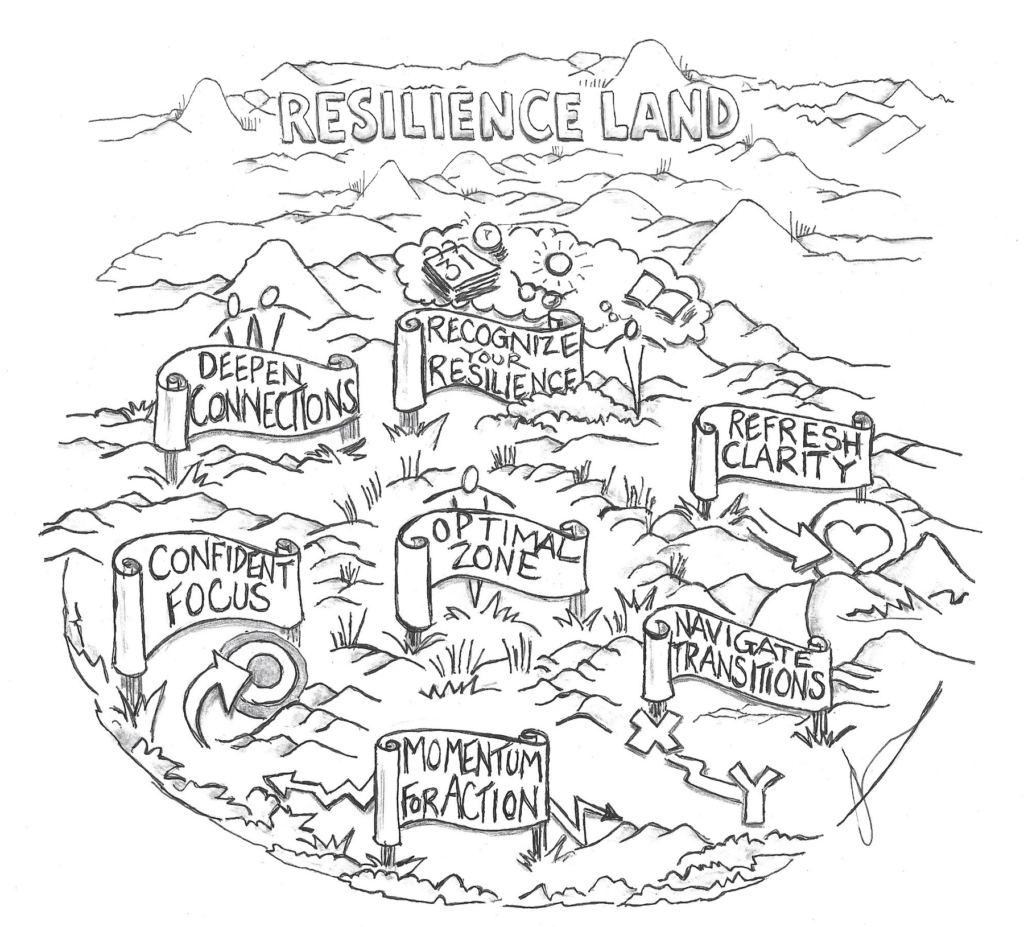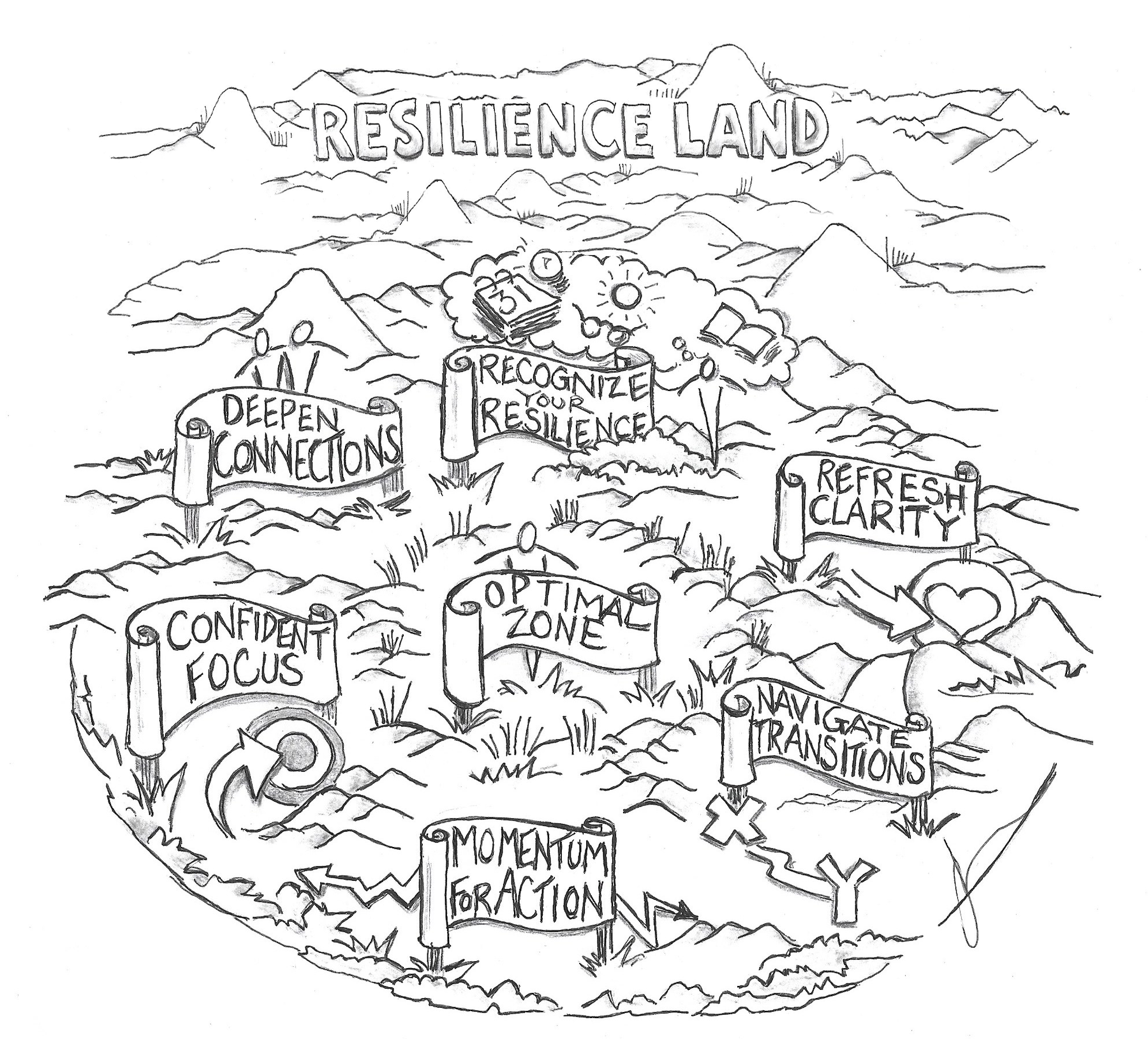Resilience is not about being untouched by adversity
or unruffled by difficulties. It’s to play an active role
in how difficulty transforms you.
Kelly McGonigal
Leaders have always been resilient
Especially in these times of a pandemic, seismic cultural shifts and global volatility. Leaders need an extra strong dose of this capability to continue to lead themselves and their organizations. I find guidance from Joshua Cooper Ramo who predicted this kind of environment when he wrote his book, The Age of the Unthinkable in 2009. He offered some important perspectives from history that encourage us to engage in being resilient enough to take more risks to uncover more opportunity and follow the pattern of winners who have always engaged in more change.
How can we get ready for more complexity and adaptation?
We are living examples of our ability to recover from adversity and pursue our goals despite challenges. Let’s imagine, for a moment, that we are more resilient than we give ourselves credit for. Perhaps this happens because we have a natural instinct to focus on problems instead of what is working. Our brains are hardwired to pay attention to differences in our environment and therefore, we experience disruption as a threat.
Resilient leaders say “Yes” to 5 Questions
In my workshops I often ask people to think about a time in their lives when they faced adversity and restored their resilience. Over many years a shared pattern has emerged where they describe actions that affirm each of these following questions.
- Did you make sense of what was happening in a meaningful way?
- Did you go beyond your limits?
- Did you take direct action on things that you could control?
- Did you calm your body and mind?
- Did you feel connected to and supported by others?
Most often they indicate that a number of the above responses were taking place, often at different levels of awareness and engagement. This exercise validates a “map” of five mindsets/practices/approaches that have been shown by research on people who have sustained their courage and stamina to regain their lives and those that thrive through the life cycle.
The 5 C’s
I represent the 5 capabilities of resilience as the map at the top of this post. Viewing this as Resilience Land encourages the spirit of adventure and complexity in navigating complex environments. Each of the 5 C’s represents a territory with its own challenges and set of approaches. All of these competencies are important to sustaining resilience as a person, team member and leader.

Coherence, Control, Centered, Challenge, Connection
The Discovery of Resilience Land
My research began with a curiosity to explore what primary care physicians do to overcome burnout and stress in high demand environments. I drew on prior research on hardiness, burnout and stress prevention and risk reduction. The focus initially was on enhancing stress management skills and practices and buffering individuals to cope more creatively with high demand situations. All that time the environmental conditions/structures in which they worked was not actively considered to be involved or a target of change.
As my experience with organizations grew it became clear to me that the interaction between the environment (culture, practices, policies, leadership) and the levels of stress in the professionals was connected. My practice shifted from “buffering” the individuals to engaging more systematically with leaders to shift the working conditions/culture as a vital source for change.
5 C’s serve as a Personal and Organizational Compass
Over the years these 5 C’s have served as a useful framework for leaders to increase their personal capacity and assess and prioritize ways to navigate strategic redirection and enhance renewal and transformation for their teams and organizations.
-
Applications for Individual Resilience
Resilience can be built, like a muscle, overtime with practice, attention and feedback. Individual leaders can use the 5 elements as a framework to articulate developmental areas and acknowledge unidentified capacities.
-
Applications for Resilient Leadership
Each of the 5 elements that support individual resilience can be used to create the conditions for teams and organizations to thrive. They give guidance for balancing and buffering areas that are impacted by turbulence and provide a way for the leader to focus on actions that will provide renewal and resilience.
- Coherence-Understand your strengths and acknowledge what you have already accomplished. Own your history. Begin to create your future capabilities. Identify milestones that will indicate success and satisfaction for you. Reframe past and current experiences as opportunities for growth and purpose fulfillment.
- Coherence– Talk about the future in a way that makes sense and has a way for everyone to participate. Describe what you see ahead, share milestones to indicate what is worth working toward. Give others the time to make sense of what is happening. Affirm core values connecting to past performance. Engage in redefining what success and satisfaction would look like, reset expectations.
- Control– Identify areas that you can and can’t control, experiment with exploring possibilities for influence. Reestablish patterns that help you create momentum and a sense of accomplishment. Make choices where you can and participate to explore options. Deepen your self-care practices.
- Control– Talk about what has not changed, reestablish patterns, rhythms, and workplace rituals. Identify what you know, what are the opportunities for choice, involvement and participation. Help to focus on what can be done now, with the choices available. Identify what they can count on you for.
- Challenge– Identify your self-limiting beliefs and reframe positive outcomes. Stretch your capacity to see options and experiment with being uncomfortable. Build momentum with step-by step actions with thing you can do better. Acknowledge your increasing confidence and support others to do more of what is working.
- Challenge– Encourage stretch in areas of strength, build on what is already working. Support risk taking in the direction of where adaptation is needed. Identify opportunities for improvement and innovation, build confidence and comfort for trying and learning.
- Connection-Acknowledging others who have helped you along the way. Recognize and affirm the importance and impact of other support and encouragement during challenges. Repair and rebuild relationships that have been disrupted, express your appreciation and gratitude for others.
- Connection-Affirm shared experiences and express your appreciation and gratitude for others. Make time to connect with others before jumping into work talk. Acknowledge what has brought you together and listen to their concerns. Cross-functional boundaries to create relationships to gather useful insight and feedback.
- Centered-Having the capacity to calm your body and mind when confronted by complexity and volatility. Practice being able to shift mental and physical experience in face of threat and stress. Know how to access calm and balance in mind, body, feelings when clarity and empathy are needed. Having a set of self-regulation practices to use in the face of threat and stress.
- Centered-Encourage others to shift their mental and physical experience in face of threat and stress. Support others to access calm and balance in order to create time to find clarity and empathy. Engaging others in practices that help them pause, gather, settle and focus to find realistic optimism.
Resilience is the new core competency for leaders
The capability of resilience has long been an underlying marker for leaders who create success over and over again. Resilience can be learned and developed to provide a strong framework for making choices for personal and organizational actions. The synergy of connecting the resilience of the leader to create a positive impact on employees and organizational culture is emerging from our current experience and can be passed on to the next generation of leaders.



